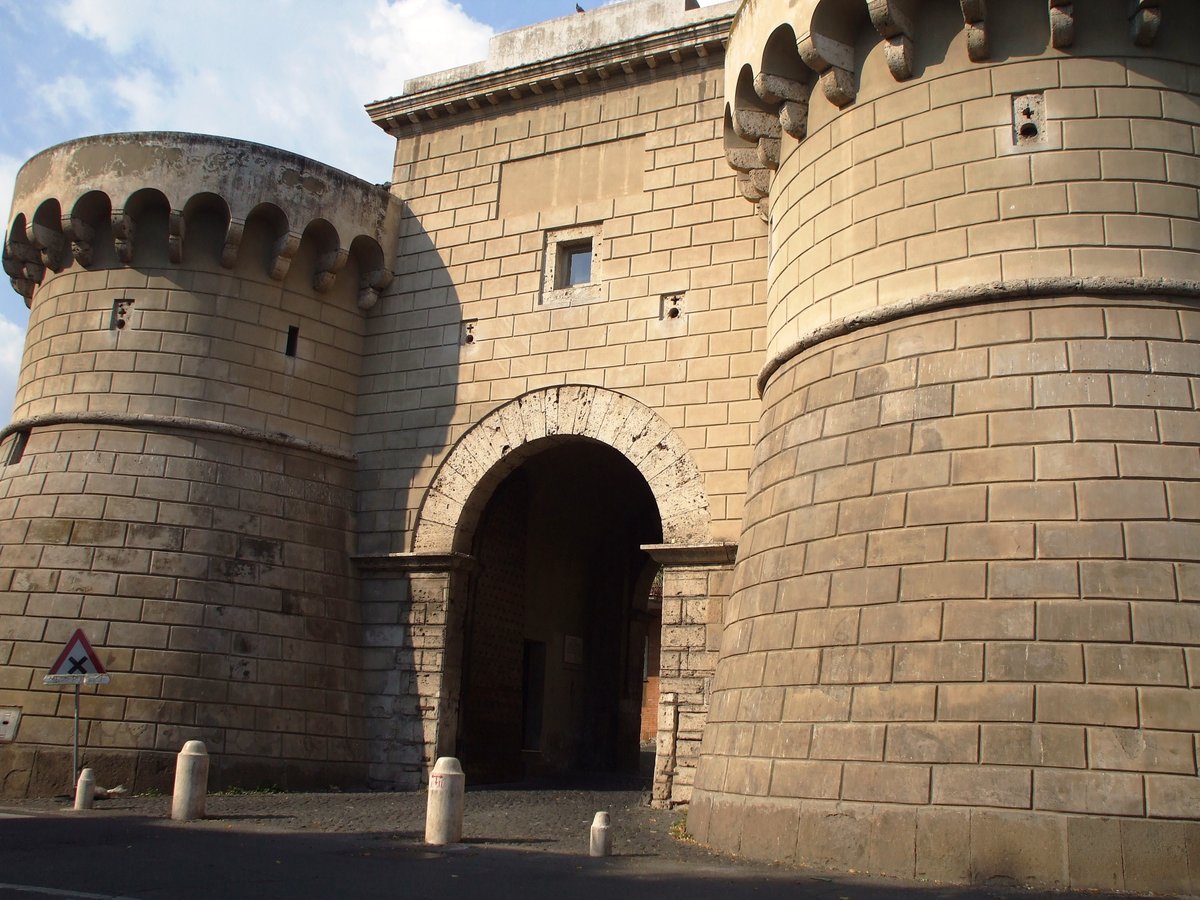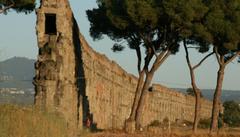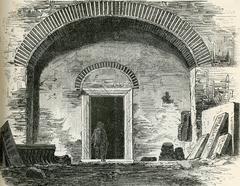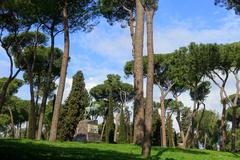
Visiting Porta Napoletana in Grottaferrata: History, Tips, and Visitor Information
Date: 01/08/2024
Introduction
Porta Napoletana, a historic gateway located in Grottaferrata, Italy, is a landmark rich in history and architectural significance. Constructed as part of the town’s fortifications, this gateway has witnessed countless historical events and has served various purposes over the centuries. Originally built to protect the town and its abbey from invasions, Porta Napoletana stands as a testament to medieval fortification techniques and the strategic importance of Grottaferrata. The town itself, founded in 1004 by St. Bartholomew and St. Nilus of Rossano, is home to the Abbey of Saint Nilus, a significant religious site that continues to attract pilgrims and tourists alike (Visit Castelli Romani). Today, Porta Napoletana not only embodies the town’s historical and cultural heritage but also serves as a gateway to understanding the rich past of Grottaferrata and its role in regional defense and trade networks.
Table of Contents
- Introduction
- History of Porta Napoletana
- Cultural Significance
- Visitor Information
- Visitor Tips
- Preservation Efforts
- Cultural Impact
- FAQ
- Conclusion
History of Porta Napoletana
Origins and Construction
Porta Napoletana, located in Grottaferrata, Italy, is a historical gateway that has stood the test of time, serving as a significant landmark in the region. The town of Grottaferrata itself has a rich history dating back to the year 1004 when St. Bartholomew and St. Nilus of Rossano founded the Abbey of Saint Nilus (Visit Castelli Romani). The Porta Napoletana was constructed as part of the fortifications that protected the town and its abbey from various threats over the centuries.
Architectural Features
The architectural design of Porta Napoletana reflects the medieval fortification techniques used during its construction. The gateway is characterized by its robust stone structure, which was essential for defense purposes. The design includes a large archway that allowed for the passage of people and goods while providing a strategic point for monitoring and controlling access to the town. The fortifications, including Porta Napoletana, were later enhanced by Cardinal Giuliano della Rovere, who fortified the community to protect it from the Borgias (Renato Prosciutto).
Renovations and Restorations
Over the centuries, the Porta Napoletana has undergone several renovations and restorations to preserve its structural integrity and historical significance. These efforts ensured that the gateway remains a well-preserved example of medieval architecture (Visit Castelli Romani).
Historical Significance
Porta Napoletana has witnessed numerous historical events that have shaped the town of Grottaferrata. During the 15th century, the gateway played a crucial role in the defense against invasions and conflicts. The fortifications were particularly significant during the periods of political instability in Italy, providing a safe haven for the residents and the monks of the Abbey of Saint Nilus. The gateway also served as a checkpoint for pilgrims and merchants who visited the town, especially during the annual National Fair, which has been held since the 11th century (Visit Castelli Romani).
Cultural Significance
Religious Importance
Porta Napoletana is not just a historical structure but also a symbol of the town’s religious heritage. The gateway leads to the Abbey of Saint Nilus, a significant religious site that has been a center of spiritual and cultural activities for over a thousand years. The abbey is home to the Basilian monks who follow the Byzantine rite, and it houses exquisite Byzantine mosaics and rare manuscripts (Welcome Rome).
Annual National Fair
The Porta Napoletana also holds cultural significance due to its association with the National Fair of Grottaferrata. This fair, which has been held annually since the 11th century, attracts pilgrims and merchants from various regions. The gateway serves as the main entrance for visitors attending the fair, making it a focal point of cultural exchange and economic activity (Visit Castelli Romani).
Visitor Information
Visiting Hours and Tickets
Porta Napoletana itself does not have specific opening hours as it is an open gateway. However, visitors planning to explore the Abbey of Saint Nilus and other nearby attractions should check their respective opening hours and admission fees. The abbey typically welcomes visitors throughout the week, with guided tours available for a more in-depth experience (Abbazia Greca di San Nilo).
Location and Access
Visitors can reach Porta Napoletana and Grottaferrata by various means of transportation. By car, the town is accessible via the Via Anagnina (Provincial road SP511, exit 22 from the Grande Raccordo Anulare ring road around Rome). Public transport options include taking a train from Roma Termini to Frascati and then a bus to Grottaferrata (Renato Prosciutto).
Accessibility
The gateway is situated in a pedestrian-friendly area, making it accessible for most visitors. However, the historical nature of Porta Napoletana and the surrounding area means that some parts may not be fully accessible to visitors with mobility issues. Efforts have been made to accommodate all visitors, and it is advisable to contact local tourist information services for specific accessibility details.
Visitor Tips
How to Get There
Visitors can reach Porta Napoletana and Grottaferrata by various means of transportation. By car, the town is accessible via the Via Anagnina (Provincial road SP511, exit 22 from the Grande Raccordo Anulare ring road around Rome). Public transport options include taking a train from Roma Termini to Frascati and then a bus to Grottaferrata (Renato Prosciutto).
Best Time to Visit
The best time to visit Porta Napoletana is during the spring and early summer months when the weather is pleasant, and the National Fair is held. This period offers a unique opportunity to experience the cultural vibrancy of Grottaferrata and explore its historical sites.
Nearby Attractions
While visiting Porta Napoletana, tourists can also explore other attractions in Grottaferrata and the surrounding Castelli Romani region. Notable sites include:
- Abbey of Saint Nilus: A must-visit for its historical and religious significance, featuring Byzantine mosaics and a museum (Lonely Planet).
- Catacombs Ad Decimum: Well-preserved Christian cemeteries from the 3rd to 5th centuries, located just outside the town center (Renato Prosciutto).
- Villa Grazioli: A splendid 16th-century villa with beautiful frescoes, now a hotel and restaurant (Visit Castelli Romani).
Local Cuisine
Visitors should also take the opportunity to savor the local cuisine of Grottaferrata. The town is known for its traditional Italian dishes, including pasta, pizza, and local wines from the Castelli Romani region. Dining at local restaurants provides a taste of the rich culinary heritage of the area.
Preservation Efforts
The preservation of Porta Napoletana is a collaborative effort involving local authorities, historians, and conservationists. These efforts ensure that the gateway remains a well-preserved historical landmark for future generations to appreciate (Visit Castelli Romani).
Cultural Impact
Porta Napoletana is not just a historical structure; it is a symbol of Grottaferrata’s rich cultural heritage. The gateway has witnessed centuries of history, from the medieval period to modern times. It stands as a reminder of the town’s strategic importance and its role in regional trade and defense networks. The Porta Napoletana continues to be a source of pride for the residents of Grottaferrata and a significant attraction for visitors interested in exploring Italy’s historical and architectural treasures.
FAQ
Q: What are the visiting hours for Porta Napoletana?
A: Porta Napoletana itself is an open gateway and does not have specific visiting hours. However, attractions like the Abbey of Saint Nilus have specific hours, so it is advisable to check their schedules.
Q: Do I need tickets to visit Porta Napoletana?
A: No tickets are required to visit Porta Napoletana as it is an open public area. Tickets may be required for associated attractions like the Abbey of Saint Nilus.
Q: How can I get to Porta Napoletana?
A: The gateway is located in Grottaferrata and is accessible by car or public transport. Detailed directions are available above.
Q: Are there guided tours available?
A: Guided tours are available primarily for the Abbey of Saint Nilus and the surrounding historical sites. It is recommended to book in advance to ensure availability.
Call to Action
Ready to explore the historical treasures of Grottaferrata? Plan your visit to Porta Napoletana today! For more information on guided tours and other historical sites, download our mobile app, check out our related posts, and follow us on social media for the latest updates.
Conclusion
In conclusion, Porta Napoletana in Grottaferrata is more than just a historical structure; it is a symbol of the town’s resilience and rich cultural heritage. From its origins as a defensive gateway to its role in religious and cultural activities, Porta Napoletana has remained a significant landmark over the centuries. Visitors to Grottaferrata can explore this historic gateway and gain insights into the town’s strategic importance in medieval times, its architectural marvels, and its cultural vibrancy. The gateway’s preservation efforts ensure that this historical treasure continues to be a point of pride for the residents and a fascinating attraction for tourists. Whether visiting during the National Fair or exploring nearby sites like the Abbey of Saint Nilus, Porta Napoletana offers a unique glimpse into the past and an enriching cultural experience (Visit Castelli Romani, Renato Prosciutto).
References
- Visit Castelli Romani (n.d.). Neapolitan Gateway. Visit Castelli Romani.
- Prosciutto, R. (n.d.). Grottaferrata Travel Guide. Renato Prosciutto.
- Abbazia Greca di San Nilo (n.d.). Abbazia Greca di San Nilo.
- Welcome Rome (2023). The Enchanting History and Artistry of Grottaferrata San Nilo Abbey: A Glimpse into Centuries of Spiritual Heritage. Welcome Rome.
- Lonely Planet (n.d.). Abbazia Greca di San Nilo. Lonely Planet.
- Visit Castelli Romani (n.d.). Grottaferrata. Visit Castelli Romani.
- Visit Castelli Romani (n.d.). Grottaferrata Travel Guides. Visit Castelli Romani.







